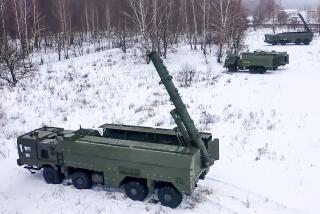Deadly Conflicts of Strategy
- Share via
Some years ago, the Department of Energy advertised for bids to design and build nuclear warheads that would burrow into the ground before they exploded. The Pentagon had already invented “black” programs whose purposes and very existence were as secret as their budgets. So it seemed fair at the time to assume that, by going public, Washington was buying a war of nerves along with research on a weapon that would probe underground for Soviet leaders in command posts during some future nuclear crisis.
Whether the research paid off is not known but, as Times writer Robert C. Toth reported recently, Soviet leaders are targets with a higher priority than ever before, according to the seventh and latest master plan for American use of nuclear weapons to be drafted since the Cold War began. Whether the architects of the plan, known as the Single Integrated Operational Plan, discussed how one would negotiate an end to a nuclear exchange short of Armageddon if the leaders on one side had all been wiped out by burrowing warheads also is not known. That is one of many questions about and conflicts within America’s nuclear strategy that Toth examined in disturbing detail in a three-part series this week.
The conflicts are important because of the difference between building up armed forces and tearing them down under rules that are likely to be set forth in future arms control treaties. The nuclear buildup during four decades of Cold War was chaotic, guided as much by rivalries among the services for their own special weapons systems as by calm planning in which weapons were selected to perform missions as part of an integrated pattern of defense or offense. The United States could tolerate chaos then because it could afford it. With attacks on the deficit driving down defense budgets, the same ragged approach to planning for changes in mission under new treaties could lead to gaps in some parts of the U.S. defense network and overkill in others.
How well Washington makes the next phase of the nuclear age work depends on how deeply President Bush gets involved. That in turn depends on how critically he reads the new master plan for war, the Standard Integrated Operating Plan 7, now being polished for his signature.
The most fundamental conflict in strategy has not changed since Hiroshima. Air Force leaders still think of attack first and defense second. Forced to choose between big missiles with many warheads and smaller missiles with a single warhead, the Air Force has gone for the one that could do the most damage, even through smaller missiles are less likely to tempt an adversary to launch a preemptive first strike.
Trying to paper over the fundamental split in philosophy has never worked very well. Most recently, compromise has yielded proposals to include in the nation’s nuclear force both single-warhead Midgetman missiles that would be moved around on trucks to make them harder to target and 10-warhead MX missiles that would be moved around on railroad flatcars. Votes in Congress on this plan last week were based largely on politics, with little attention to what made sense in nuclear planning terms.
The new SIOP calls for a long list of new weapons and sophisticated satellites that might well be necessary in a shooting nuclear war if there were no holds barred. But many holds would be barred by arms-limiting treaties already being negotiated.
Toth reported that the Strategic Arms Reduction Talks, or START, offer a “priceless opportunity” to correct mistakes made during the chaotic years of buildup, such as building and aiming three or four missile warheads at targets that could be destroyed with one warhead. But if there is no change in the way military decisions have been made during the last generation, START could as well be an opportunity to make entirely new mistakes.
Washington does not have to wait for the new SIOP to test the government’s ability to make better military decisions than it did during the chaotic buildup of the Cold War. The controversial B-2 Stealth bomber program will be test enough. The Bush Administration is promoting the B-2 as an essential weapon of the future. Congress is not persuaded and wants more evidence that the Stealth not only can do what the Air Force says it can do but also that the mission it would carryout makes sense. Congress is wise to reserve judgment.
More to Read
Sign up for Essential California
The most important California stories and recommendations in your inbox every morning.
You may occasionally receive promotional content from the Los Angeles Times.













